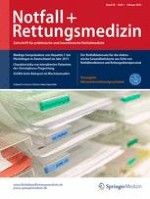25.01.2017 | CME
Passagere Herzunterstützungssysteme
Erschienen in: Notfall + Rettungsmedizin | Ausgabe 1/2017
Einloggen, um Zugang zu erhaltenZusammenfassung
Als mechanische linksventrikuläre Unterstützungssysteme für Patienten mit konservativ nichtstabilisierbarer Herzinsuffizienz stehen die intraaortale Ballonpumpe (IABP), die Impella™-Pumpe, das TandemHeart™ und die extrakorporale Membranoxygenierung (ECMO) zur Verfügung. Aufgrund ihres Unterschieds in Aufbau und Wirkweise sind die spezifischen Indikationen und der individuelle potenzielle Nutzen für den Patienten zu berücksichtigen. Anhand der Haupteinsatzgebiete kardiogener Schock, prophylaktische Anlage bei kardialen Hochrisikoeingriffen und Reanimation ohne Wiedererlangen eines Spontankreislaufs werden die Systeme im Folgenden beleuchtet. Mechanische linksventrikuläre Unterstützungssysteme sind komplikationsbehaftet; sowohl akute als auch erst nach Explantation auftretende vaskuläre Komplikationen sind zu beachten. Diese sind dem potenziell lebensrettenden Nutzen gegenüberzustellen und können durch Expertise, Weiterentwicklung der Systeme und verbesserte Nachsorge reduziert werden.
Anzeige















